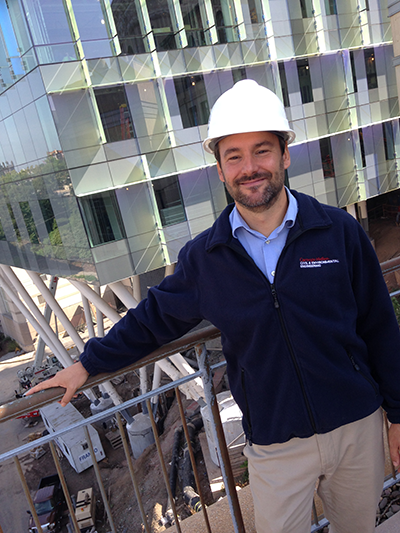Do sensors make infrastructure safer?
When should we apply sensors to monitor the state of our infrastructure in a way that could help predict and prevent failure? Matteo Pozzi and his group recently developed a framework to evaluate when it could be of significant benefit to apply a sensing system.
Simply driving down the road gives you a sense for the current state of our infrastructure: crumbling and in need of repair. Aside from retrofitting or replacing current infrastructure with new construction and materials, new technology like sensors offers a way for inspectors to peer inside the systems almost continuously.
But just placing a sensor on the side of a bridge doesn’t automatically lead to cost savings and a safer bridge. Instead deploying these sensors is costly and depends on how a variety of factors work together in order to be beneficial.

Source: College of Engineering
Matteo Pozzi in front of Scott Hall.
Researchers from Carnegie Mellon University’s Civil and Environmental Engineering (CEE) Department are studying the impact of information in decision-making for infrastructure systems, leveraging previous work with CEE alumnus Milad Memarzadeh. In a paper recently published in Structural Control Health Monitoring, CEE Professor Matteo Pozzi and Ph.D. student Shuo Li proposed a general framework that evaluates the benefit of applying sensing and monitoring systems to infrastructure based on information surrounding the infrastructure component.
Imagine you are a bridge inspector and you want to know what’s going on inside of the structure. The different components of the bridge change state due to aging and degradation, so there is uncertainty about a component’s current condition and how it will degrade over time. A sensor or monitoring system would provide a flow of information that would give you this information, and you could periodically check the state of the component with some level of precision. If used properly, the system could prevent a bridge collapse. At the same time, it could also save you from unnecessary repair when the bridge doesn’t need it.
Investments in infrastructure can have a significant payoff through incremental safety and the reduction of congestion and problems due to the transportation network.
Matteo Pozzi, Associate Professor, Department of Civil & Environmental Engineering
“It’s not so obvious how much of an investment should be directed toward sensors, and how much should be directed to retrofitting and replacement,” said Pozzi. “It’s still ongoing work, assessing what structures should be monitored and how much to invest in each of them.”
In a perfect world, we would apply sensors to every infrastructure system. But because funding resources are limited and sensing systems can be expensive to implement and maintain, instrumenting every bridge with a sensing system isn’t the answer. Therefore, it’s important to evaluate the actual value of the information that the sensors provide.
The framework proposed by Pozzi and Li found that there are several key factors that determine the value of sensing: how quickly the component degrades, what actions you can take for coping with the degradation, the economic costs related to maintenance, the cost of repairs, the costs related to the failure or malfunction of the sensor itself, how precise the sensor is, how frequently the sensors give you a response, and how quickly you can react to the information from the sensor. For example, if a sensing system provides accurate information but the manager cannot react quickly to the information to mitigate the issue in time, it may not be worth the cost to have sensors. When resources are limited and it’s complicated to allocate funds in complex infrastructure systems, the framework seeks to provide quantitative guidance.
“Investments in infrastructure can have a significant payoff through incremental safety and the reduction of congestion and problems due to the transportation network, for example,” said Pozzi. “Among these investments, some could be allocated to retrofitting or replacing infrastructural components, and some could also be allocated to sensors. Our framework is geared toward entities that have to control and guarantee the safety of a built environment, to help them make important decisions regarding our infrastructure systems.”
